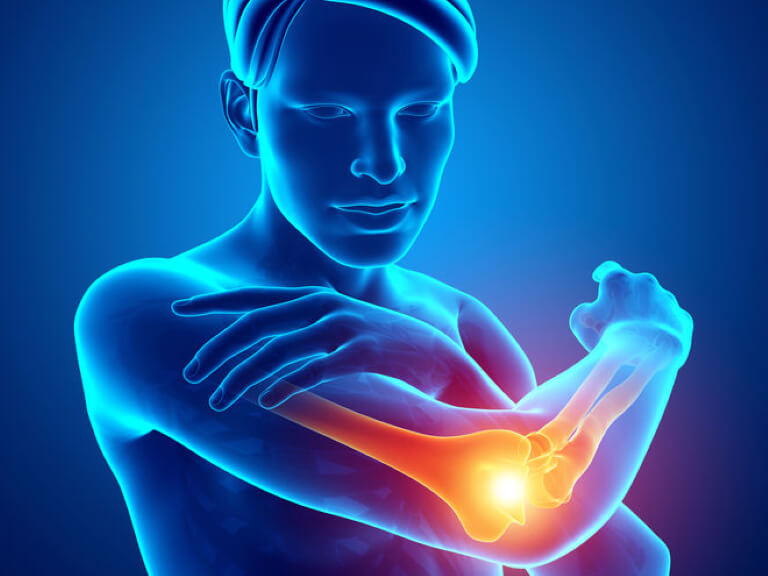Do you get a pain on the inside or outside of your elbow? Does it get worse when you use your lower arm, like playing tennis, golf, lifting something, or even pulling something? Three percent of all people in America suffer from elbow tendonitis according to the Cleveland Clinic. You can read the paper at https://my.clevelandclinic.org/health/diseases/7049-tennis-elbow-lateral-epicondylitis Medical names of this include medial epicondylitis, golfer’s or pitcher’s elbow, and lateral epicondylitis, tennis elbow. Many people will wear bands on their forearms hoping to ease the pain and when it gets worse, will endure injections, and possibly surgery. Luckily for you, there is a better way to deal with elbow tendonitis.
What is Causing my Elbow Tendonitis?
Most people believe that their pains just happen out of bad luck unless there is a trauma they can point to. Some will blame it on their age, and it is true that elbow tendonitis usually affects people, age thirty to fifty. However, it has little to do with your actual age and more to do with how much you use your lower arm. We hear of elbow tendonitis most commonly with people who participate in sports like golf, tennis, baseball, and lacrosse because they all use a racquet, bat, or stick. You can also get elbow tendonitis from gripping too hard on a steering wheel, typing on a computer, texting on a phone, or anything that requires you to use your hands and lower arm.
Let’s dive into what elbow tendonitis actually means. Obviously, we know what elbow means, however, tendonitis means the inflammation of the tendon at the elbow. If you are told you have medial epicondylitis, the pain will be on the inside of the elbow. If you have lateral epicondylitis, the pain will be on the outside of the elbow. This is important to understand as it will help you resolve the pain once and for all.
From the elbow to the tips of your fingers there are 26 muscles that control the hand in opening and closing of the hand, rotation of the hand and lower arm, and bending of the hand up and down and side to side. Inside the lower arm are two bones that rotate with the five carpal bones of the wrist and the one large bone of the upper arm. There are five muscles on the top side of the arm that allow you to open the hand and, like in tennis, perform a backhand shot on the court. As you are hitting the ball, gripping the racket, you are using the outside forearm muscles to power the ball back to your opponent. Continual use of this area of the arm will lead to lateral epicondylitis, tennis elbow.
The forehand shot in tennis, golf swing, bat swing, and lacrosse swing all place pressure on the inside of the elbow and usually leads to medial epicondylitis. This is why you may feel pain on the inside of the elbow. The more you use these muscles, the harder and larger they get. Plus, the pain you may feel will get worse.
If you feel both sides of your elbow, you can feel a knot on the outside and on the inside. These are the epicondyles on the lower end of the upper arm bone or the Humerus. There are five muscles that attach to both of these epicondyles and the muscles run down your arm to your fingertips. Make a fist and watch how your forearm moves. Open your hand and watch how it moves differently.
The forearm and the hand were the most difficult thing to duplicate on robots due to the complexities of this area. There are many different movements that are available to us with our hands, including the thumbs for gripping everything we pick up.
Common Ideas to Stop the Pain
There are many different ideas for resolving elbow tendonitis, but sadly, many fail as they are only trying to resolve the symptom versus the real cause. It is easy for me to see you have tight forearms as I work on many different sets of forearms each day. Unfortunately for you, you probably only touch one set in your lifetime – your own. Even if your forearm is hard as a rock, it may just feel normal to you. This is part of the frustration for you. I will show you how to improve how you feel your own forearm at the end of this newsletter.
Let’s go through these pain resolution ideas to better understand why they are not working so well.
1- The most common device to help with elbow tendonitis is the Velcro band. We have all seen people wearing these just below the elbow. In fact, I just saw a drummer for a band on TV wearing a set and I am sure he has elbow tendonitis. The purpose of the Velcro band is to apply enough pressure to the muscles to reduce the pressure on the epicondyle to slow the pain. Keep in mind that even though you are applying this pressure, you are still using the muscle and the pain will increase over time.
2- Lotions are commonly used in most cases of elbow tendonitis. Some lotions have a heating component to them which can help reduce the pain. Others may have minerals to help reduce inflammation. Unfortunately, when you use your arms again, the inflammation will come back and so will the pain.
3- Rest is a common thing most doctors recommend. It is true if you rest your arm, the inflammation will go down and the pain will stop. The problem here is, you love to play your sport or activity and you don’t want to stop. Again, each time you go back to doing what you enjoy, the pain comes back.
4- Finally, when all else fails, we can try an injection. This may relieve the pain for two or three months then you will have to do it again. Besides the pain of the injection, you are waiting for the pain to re-occur. This can be frustrating, and expensive.
There is a better way. Learning how to soften your muscles and stretch them correctly each day will prevent the pain from coming back. The side benefit is, you will have better control of the racquet, bat, club, or stick than ever before. The bonus is you will have no pain!
All you need is your two hands, a little time, and patience. Let’s begin with softening the muscles. If you are working on your right arm, place your left hand on the right forearm. You can either press with your thumb, which is what I do, or your four fingers if your thumb hurts. I begin at the elbow and work down to my wrist. I squeeze my right arm, spot by spot looking for sore spots. I will squeeze all over the forearm. When I find a sore spot, I breathe out, and allow the muscle under my thumb, or fingers, to relax. While I am squeezing my right arm, I will rotate my right arm, so I am pushing the muscle into my left thumb. I would do this on the top and bottom of my forearm to be sure that neither epicondyle is sore. At first this may be painful. If it is, reduce the pressure enough that you can breathe out and relax the muscle. As the arm softens, the pain will disappear, and your arm will get softer. Below I have added two stretches for this area of the forearm. I would do these at least twice a day, more if you can until the pain stops completely. If the pain is bad at the beginning, lay your arm on a heating pad as you work to soften it. The heat will force warm blood into the tissue making it easier to soften it.
Once the pain stops, you must do this every day for the rest of your life. It only takes about five minutes at a time, and it will prevent it from coming back. Many times, I work on my forearms sitting at a stoplight, or when I am talking to friends. I have actually worked on my forearms speaking on stage in front of 50 people. I was demonstrating this to a gentleman who claimed he didn’t have time to do it and asked what I would suggest he do. So I showed him. It got a huge laugh from the audience.
Tips to Improve your Stretching
All you need is a yoga strap and a tennis ball for the tennis ball massage. Give yourself about 15 minutes twice a day and you should see better results within 2 weeks. This, though, is a lifetime event. Think of your pet. they stretch everyday and several times a day. Stretch when they stretch. Follow the videos below and free your knees. In my opinion, the calf stretch is the most important stretch a human can do. It will solve many issues of the body.
Wrist Flexion Stretch
Stretching is more about feeling the muscles letting go than forcing them to stretch. If you are forcing the muscle, you could be doing strength training, not stretching. Make sure you are feeling the intended muscle stretching. If not, the form could be wrong. Holding for 5 seconds allows the brain to release the muscle before it senses any danger. Repeating the stretches 10 times allows the brain to learn it is safe for the muscle to move that way.
Wrist Extension Stretch
Don’t forget the Tennis Ball Massage!
Softening your hips and back is easy when you use the tennis ball. Just lean against the wall and apply enough pressure to feel the painful area. The temptation is to press harder but resist it. Instead, breathe out and allow the muscle to soften under the ball. Then move to another spot and repeat. Continue doing this until most of the painful spots are gone.
Subscribe to my YouTube Channel for access to free videos as I post them.
Want to Talk with Me Directly? Start Here
We’re happy to offer you a complimentary 30-min virtual consultation so you can experience this for yourself. Schedule your introduction to Stretch n Release now.
About The Muscle Repair Shop
Drawing upon his personal experience as a former competitive athlete turned wheelchair, obese, and chronic pain sufferer, Muscle Repair Shop Founder Butch Phelps decided to take his health into his own hands when at the age of 36 he was told he might not make it to his 40th birthday. Applying balanced nutrition advice from his doctor along with a sound exercise program, he went from 315 lbs. to 180 lbs. Motivated by his experience, he then acquired degrees in advanced therapeutic massage and aging sciences to help people eliminate chronic pain. This included applying his expertise in how people age, including the effects of dementia, anatomy, psychology, and the day-to-day struggles living as an older person to his practice and development of The Muscle Repair Shop’s one-of-a-kind Stretch n’ Release Technique.
Available through in-office and virtual coaching treatment sessions, this unique combination of stretching and breath work teaches the brain to release the emotional side of muscle tension and pain allows clients to find lasting relief and healing from stiffness, aches, injuries, and chronic pain. The at-home exercises come with customized instructional videos and virtual or in-office support, allowing clients to enjoy and experience life and sports as they did before limitations slowed or curtailed activities.


